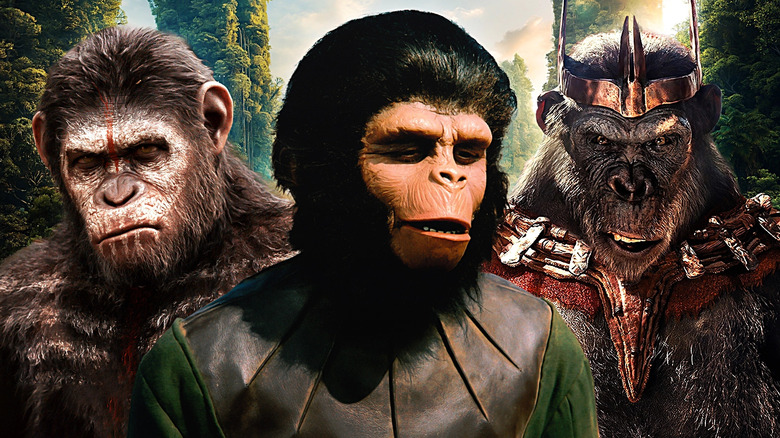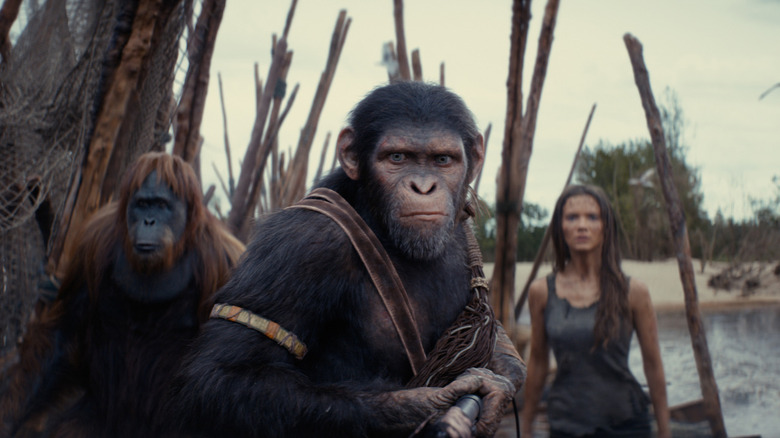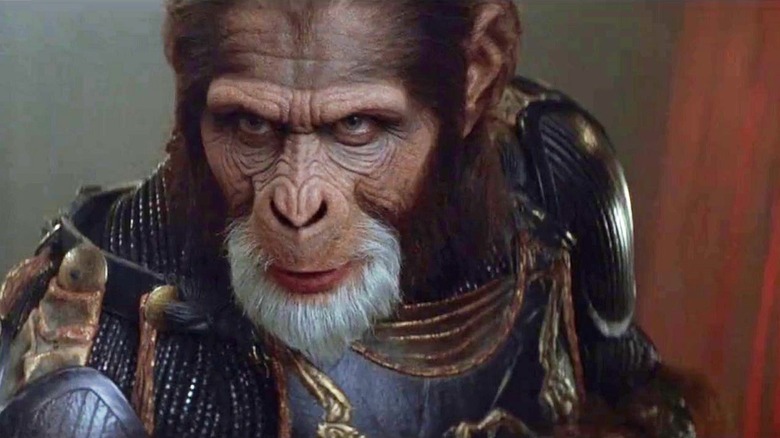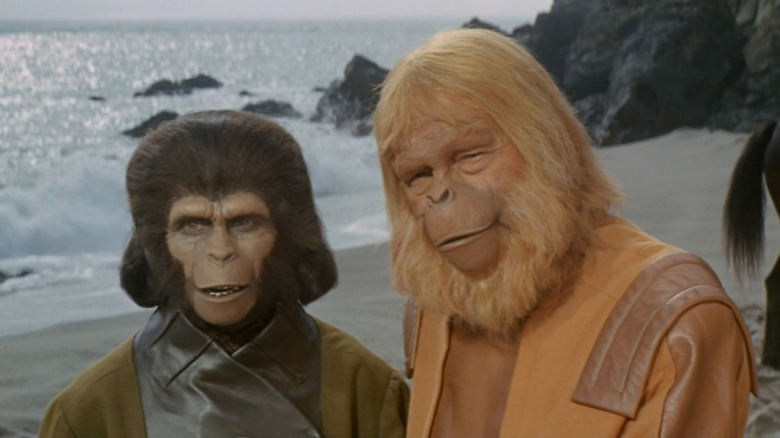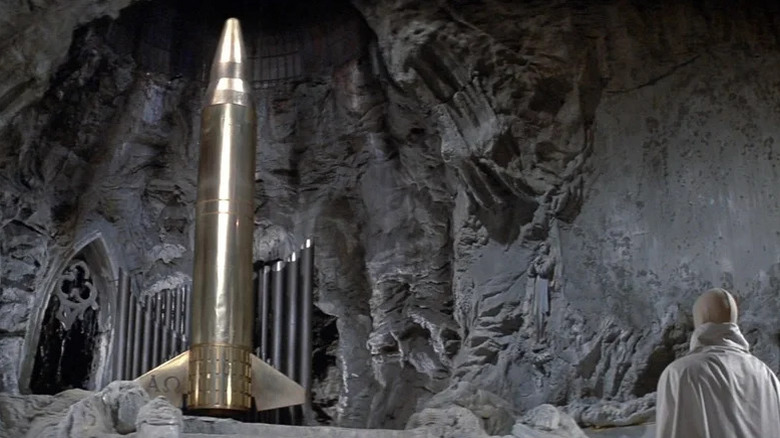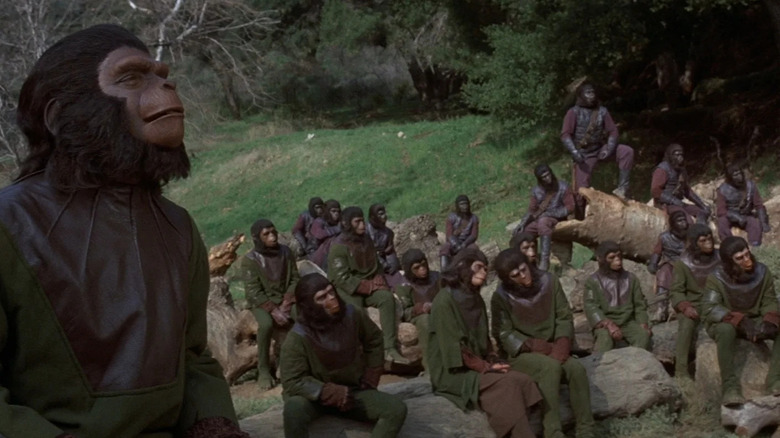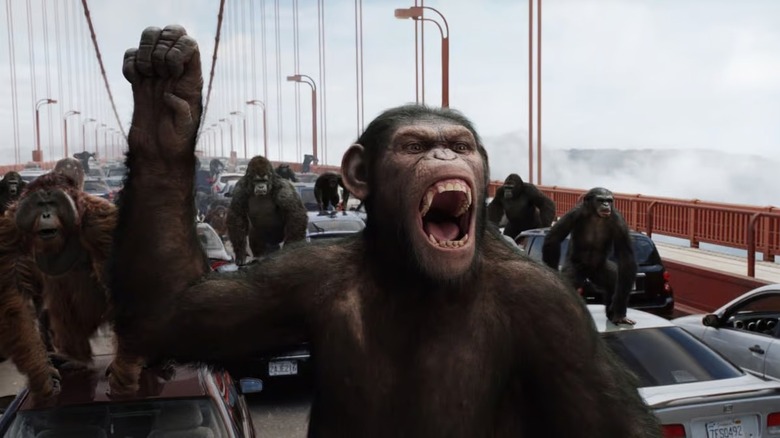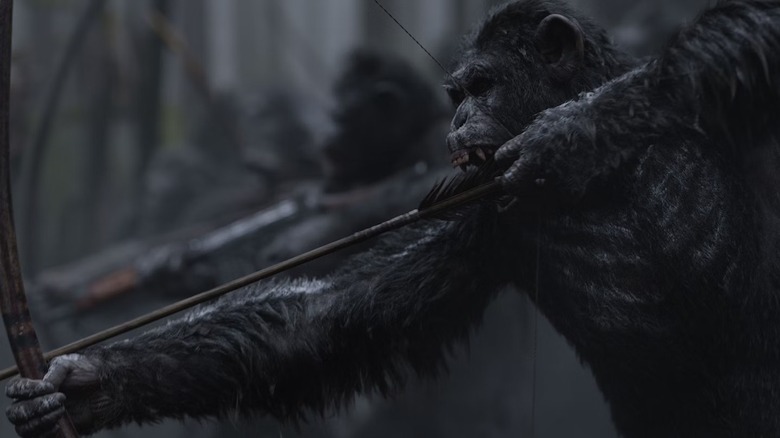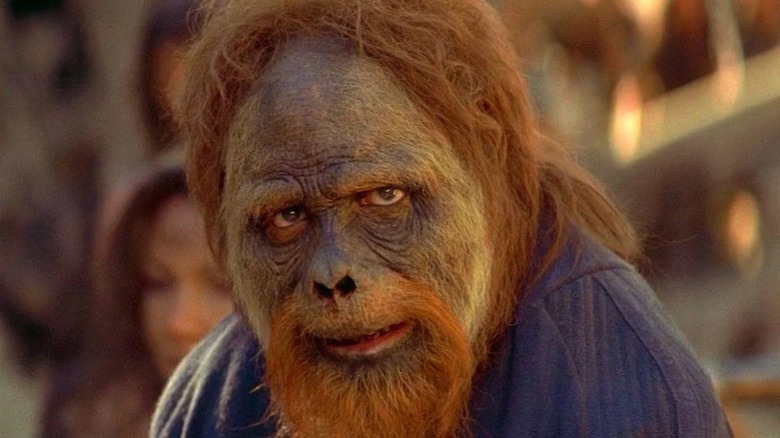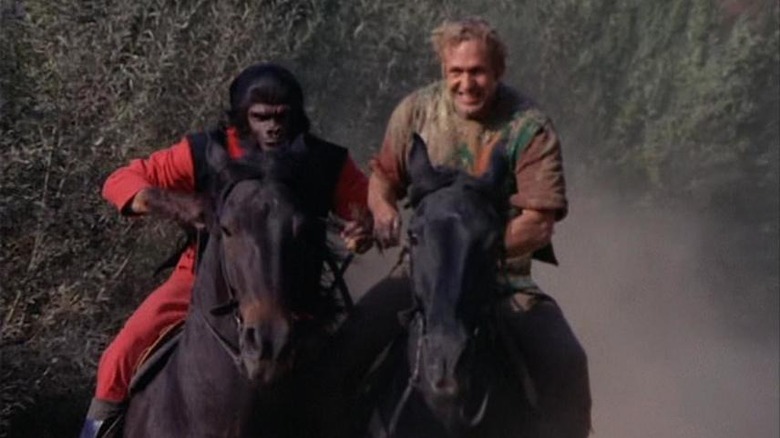How To Watch The Planet Of The Apes Movies In Order
One of the most enduring and surprisingly prolific science fiction film franchises is "Planet of the Apes," loosely based on the 1963 novel by French author Pierre Boulle. Adapted by sci-fi genre pioneer Rod Serling in 1968, the success of the original movie led to four direct sequels and a television series spin-off. Since then, the franchise has been rebooted multiple times, maintaining the core premise of an Earth ruled by intelligent apes, retooled for contemporary sensibilities. And through all of its iterations, the franchise has boasted high-concept sci-fi storytelling, along with groundbreaking makeup and visual effects to bring its wild world to life.
Given the sprawling extent of the series and its numerous continuities, first-time viewers could use a primer on how to approach the franchise. There are different ways one could watch all the "Planet of the Apes" movies, including in release order. But for those looking for an ideal way to experience the film series, we do have a recommended viewing order. Here is how to watch the "Planet of the Apes" movies in order.
The Planet of the Apes cinematic franchise overview
The original "Planet of the Apes" movie series ran from 1968 to 1973, including five theatrically released films in all. This was followed by a short-lived 1974 live-action television series and 1975 animated series, the latter of which was titled "Return to the Planet of the Apes." Six years after the live-action show's initial broadcast, most of the episodes were re-edited into five television movies, with new bookending sequences filmed for each. In these scenes, Roddy McDowall reprised his television role as Galen, recounting his adventures as an older chimpanzee.
The 21st century has seen two cinematic reboots of the "Planet of the Apes" franchise, starting with a standalone film directed by Tim Burton released in 2001. A second reboot movie, directed by Rupert Sanders, was released in 2011, leading to its own line of sequels. Neither reboot shares a continuity with the original film series launched in the '60s, though there are plenty of allusions to the classic movies.
In short, there is a ton of "Planet of the Apes" movie material to go over, so let's talk about viewing orders for the franchise.
Release order and recommended order
The most straightforward viewing order for the "Planet of the Apes" film series is to watch the installments, including its television movies, in release order. After all, this is how the general public experienced the franchise themselves, before having a wealth of movies across three continuities readily available. The "Planet of the Apes" release order is as follows:
-
"Planet of the Apes" (1968)
-
"Beneath the Planet of the Apes"
-
"Escape from the Planet of the Apes"
-
"Conquest of the Planet of the Apes"
-
"Battle for the Planet of the Apes"
-
"Planet of the Apes" TV movies
-
"Planet of the Apes" (2001)
-
"Rise of the Planet of the Apes"
-
"Dawn of the Planet of the Apes"
-
"War for the Planet of the Apes"
-
"Kingdom of the Planet of the Apes"
However, with entries like the "Planet of the Apes" television movies muddling the classic canon and the 2001 reboot being a standalone outlier, there is an alternative to release order. With that in mind, below is our personal recommended viewing order for the "Planet of the Apes" movies.
Planet of the Apes (1968)
The movie that started it all, 1968's "Planet of the Apes" stars Charlton Heston as 20th-century astronaut George Taylor, who travels into deep space in suspended animation. Crashing on a planet over 2000 years later, Taylor and his crew discover a civilization run brutally by intelligent apes, while the native humans are primal and incapable of speech. Taylor is aided by sympathetic chimpanzee scientist couple Cornelius (Roddy McDowall) and Zira (Kim Hunter) to escape from the sadistic Zaius (Maurice Evans). Venturing inside the Forbidden Zone where his spaceship crashed, Taylor finds one of the greatest movie plot twists regarding this planet's true nature.
Until the release of "Star Wars" nearly a decade later, "Planet of the Apes" held the sci-fi throne as far as critical and commercial blockbusters. For anyone approaching the franchise, this movie is still the foundation for the entire series and should be viewed first. Not only do the sequels tie directly to the original movie, but subsequent reboots contain plenty of nods and allusions to the 1968 classic. Just as entertaining and enduring as it was when it debuted over 50 years ago, the original "Planet of the Apes" is the logical starting point for any viewing guide.
Beneath the Planet of the Apes
The first "Planet of the Apes" sequel is also the bleakest movie in the franchise to date, and that's saying something considering the brutal lengths it has gone to. Shortly after Taylor and Nova (Linda Harrison) enter the Forbidden Zone, he abruptly disappears, with Nova searching for help. Nova meets Brent (James Franciscus), another 20th-century astronaut similarly time-displaced while on a mission to Taylor's team. After escaping from Ape City, Brent and Nova venture underneath the ruins of New York City, where they discover a mutated human race worshipping a nuclear weapon.
"Beneath the Planet of the Apes" begins directly after the events of the first movie, continuing Taylor and Nova's journey after finding the ruined Statue of Liberty. There is a discrepancy on when this far-future actually takes place, with the original movie's chronometer names it 3978 while its 1970 sequel places it in 3955. That said, Brent's introduction clearly takes place after Taylor's disappearance, no matter what year the spaceship chronometers display. Had Charlton Heston's intended ending occurred, "Beneath the Planet of the Apes" would've been a nail in the series' coffin, but these hardy apes found a way to survive.
Escape from the Planet of the Apes
While nuclear armageddon may have effectively destroyed Earth and most of the characters in "Beneath the Planet of the Apes," the movie received a direct sequel the following year. 1971's "Escape from the Planet of the Apes" reveals that Cornelius, Zira, and their chimpanzee colleague Milo (Sal Mineo) evaded annihilation by repairing and flying away from Earth off-screen. The shockwave from the planet's destruction catapults them back in time to 1973, where they are received by shocked humans in Los Angeles. As officials worry about the fate of humanity faced with these time-traveling apes, Cornelius and Zira go on the run as they prepare for the birth of their baby.
With its contemporary setting, "Escape from the Planet of the Apes" goes deeper with its characters rather than relying on sci-fi spectacle. The sequel's time-bending premise and the birth of Cornelius and Zira's child interestingly suggests the first three movies form a narratively temporal loop. However, as "Escape from the Planet of the Apes" received its own sequels, it becomes clear that this actually kickstarts an alternate timeline altogether. Balancing camp with social commentary, the 1971 sequel offers a slightly lighter continuation from its apocalyptic predecessor and should be watched immediately after "Beneath."
Conquest of the Planet of the Apes
1972's "Conquest of the Planet of the Apes" takes place 10 years after the events of its predecessor, set in the oppressive dystopian future of 1983. The movie centers on Cornelius and Zira's fully grown son, Caesar (Roddy McDowall), as humanity begins to employ increasingly intelligent apes for slave labor. Concealing the truth of his parentage, Caesar is subjected to the systematic cruelty shown to apes, which instills in him a hatred toward humans. After the sadistic Governor Breck (Don Murray) learns Caesar's identity, the young chimpanzee leads his fellow apes in a full-on revolution against their human overlords.
While "Conquest of the Planet of the Apes" starts out with the same campy qualities as its predecessor, it gradually progresses into one of the best sci-fi sequels ever. From its sharper social commentary to its climactic uprising, the 1972 movie brings an edge that the "Planet of the Apes" sequels hadn't employed before. The movie was originally going to go even harder with its themes and on-screen violence, before changing its ending to avoid an R-rating. As the penultimate entry in the classic movie series, "Conquest of the Planet of the Apes" clearly influenced the 2011 reboot series to come.
Battle for the Planet of the Apes
The final installment of the original "Planet of the Apes" movie series, 1973's "Battle for the Planet of the Apes," also has the franchise's most dubious Rotten Tomatoes score. Set in the early 21st century, decades after "Conquest of the Planet of the Apes," humanity is devastated by an unseen nuclear war. Caesar tries to maintain a tenuous peace between the apes and humans, but contends with the violent General Aldo (Claude Akins), a gorilla who wants to completely subjugate humanity. This is complicated by the mutated humans living underground, led by the fanatical General Kolp (Severn Darden), leading to an all-out war.
After the melancholic endings of the other sequels, "Battle for the Planet of the Apes" ends the series on a more hopeful note. Discovering archival footage of his parents, Caesar sets out to avert the apocalyptic future for the planet in his quest for peace, effectively changing future history. An epilogue 600 years in the future suggests humanity and apes finally find a way to peacefully co-exist, which is the most optimistic ending to any movie in the franchise. While low-budget and campy as all get-out, "Battle for the Planet of the Apes" closes out the cinematic story that started in 1968.
Rise of the Planet of the Apes
The 2011 reboot of the film series, "Rise of the Planet of the Apes," doesn't center on a society already ruled by simians, but rather on the origins of the apes' uprising. In this continuity, Caesar (Andy Serkis) isn't the child of time-traveling apes, but a chimpanzee exposed to experimental Alzheimer's Disease treatments. With his intelligence boosted significantly, Caesar grows to resent how cruelly he and his fellow apes are treated by their human handlers. Using a more powerful version of the drug that increased his mental capacity, Caesar upgrades the intelligence of the apes to rebel against their overseers.
While the narrative broad strokes are fundamentally similar, "Rise of the Planet of the Apes" does mark a complete reboot to the franchise's canon. The circumstances behind the apes' increased intelligence and humanity's downfall are completely different than those in the classic series, starting the story in a new direction. What the 2011 film retains is Caesar's character arc into an ape revolutionary, something that viewers can appreciate after watching the last two classic movies. A fresh take on the franchise while maintaining its core themes and overarching premise, "Rise of the Planet of the Apes" completely breathed new life into the series.
Dawn of the Planet of the Apes
2014's "Dawn of the Planet of the Apes" saw acclaimed filmmaker Matt Reeves take on directorial duties for the first time in the franchise, upping the ante considerably. Set about 10 years after the events of the 2011 reboot, the sequel has humanity nearly wiped out by the contagion unleashed in the preceding movie. Caesar leads his growing ape community near the ruins of San Francisco, where they come into contact with a small human community trying to access a hydroelectric dam for power. Though Caesar and the human Malcolm (Jason Clarke) try to maintain peace, the vengeful bonobo Koba (Toby Kebbell) pits the two groups into a fiery conflict.
"Dawn of the Planet of the Apes" is one of those rare sequels that completely outdoes many of its predecessors in virtually every way. There is a strong argument that this entry is the best movie in the entire franchise, as it transcends summer blockbuster conventions. Just as the preceding movie showed one species' rise in the wake of another's fall, the 2014 sequel highlights the inevitability of conflict. By "Dawn of the Planet of the Apes," the franchise steadily regained its cinematic prestige, which only continued moving forward.
War for the Planet of the Apes
Matt Reeves' tenure with the "Planet of the Apes" franchise, at least for the foreseeable future, came to a close with 2017's "War for the Planet of the Apes." Set two years after "Dawn of the Planet of the Apes," the movie opens with a human army attacking Caesar's colony, killing his family and forcing his community into slavery. Vowing revenge, Caesar leads his small group to the military's headquarters in the mountains where they confront its sinister leader Colonel McCullough (Woody Harrelson). As Caesar moves to liberate his apes, the last remnants of the human military go to war with each other over the fate of their species.
"War for the Planet of the Apes" closes out the story of Caesar in the 2011 reboot timeline, while giving this new continuity its own Cornelius to continue his legacy. The movie also offers its own explanation why human mental capacity had deteriorated significantly after the rise of the apes. Though the movie would leave the door open for sequels, which it has since received, the 2017 flick does feel like a conclusion of sorts. One of the most significant blockbusters of the past decade, "War for the Planet of the Apes" sticks the landing in its revival of the franchise.
Kingdom of the Planet of the Apes
The story of the 2011 reboot timeline continued in 2024's "Kingdom of the Planet of the Apes," a fresh narrative start built from the foundation of the preceding trilogy. Set several undetermined generations after the death of Caesar, apes are now the dominant species on Earth, though pockets of intelligent human communities still exist. The movie's protagonist is a young chimpanzee named Noa (Owen Teague), whose clan is conquered and subjugated by the ruthless Proximus Caesar (Kevin Durand). This leads to a cross-country odyssey, with Noa accompanied by a human woman, Mae (Freya Allan), who is interested in accessing a vault near Proximus Caesar's domain.
Opening with Caesar's funeral immediately after "War for the Planet of the Apes," "Kingdom of the Planet of the Apes" immediately reaffirms it takes place in 2011 continuity. Though its exact timeline placement is complicated, one can infer it takes place at least over a century after the preceding movie. For viewers only interested in the classic and reboot continues, they should end their binge with "Kingdom of the Planet of the Apes." For those looking to keep this simian viewing party going, there are a few outliers that can be added as standalone codas to the franchise.
Planet of the Apes (2001)
The 2001 "Planet of the Apes" reboot is a strange beast, though it does provide some interesting moments and even a few triumphs to the franchise. The movie has 21st-century deep-space astronaut Leo Davidson (Mark Wahlberg) transported to the year 5021, where he crashes on a strange planet ruled by apes. Escaping from captivity, Davidson leads a small group deep into the planet's forbidden holy zone, pursued by the merciless General Thade (Tim Roth). Reaching the reputed ancient temple within the region, Davidson learns the shocking truth about his past mission's connection to this simian-controlled society.
As a standalone reboot, the only movie not to receive a sequel or any other substantial connective material, the 2001 "Planet of the Apes" is best viewed on its own. There are definitely visibly laudable efforts within the movie, including Rick Baker's excellent prosthetic makeup for the apes. But an unresolved cliffhanger conclusion, rather than the alternate ending Tim Burton wanted, and odd creative choices certainly make this movie an outlier for the franchise. After watching the triumphant relaunch series that began in 2011, watch the 2001 reboot to see how differently a previous attempted revival could've been.
Planet of the Apes TV movies
While one might assume that the 1974 "Planet of the Apes" live-action television series shares its continuity with the preceding five movies, it has its own standalone canon. The show isn't set in the harmonious future of humans and apes peacefully co-existing that the end of "Battle for the Planet of Apes" hinted at. Instead, like the first two movies, the series takes place in a far-future where humanity has been brutally subjugated by apes. Time-displaced 20th century astronauts Alan Virdon (Ron Harper) and Peter Burke (James Naughton) team up with sympathetic chimpanzee Galen to find a way back to their time period.
Ten episodes of the series were condensed and retooled into five television movies that aired in 1980. These movies are titled:
-
"Back to the Planet of the Apes"
-
"Forgotten City of the Planet of the Apes"
-
"Treachery and Greed on the Planet of the Apes"
-
"Life, Liberty and Pursuit on the Planet of the Apes"
-
"Farewell to the Planet of the Apes"
In new wraparound sequences filmed for the movies, Galen alludes that Virdon and Burke eventually did find a way back to their native time period. The spaceship chronometer suggests Virdon and Burke arrive on Earth roughly the same time as Taylor and Brent had in the movies, though the show features pastiche ape characters instead. Completionists looking to watch every "Planet of the Apes" movie should watch these as a coda, as they're more of a point of curiosity for the franchise.
